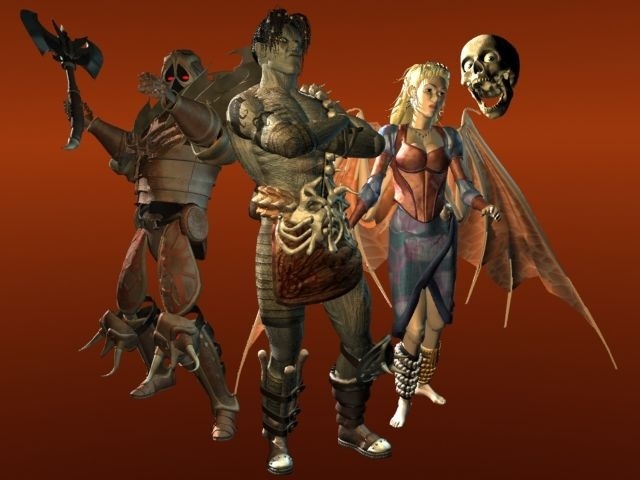Planescape: Torment and Icewind Dale: Enhanced Editions (Nintendo Switch) Review
By Coller Entragian  17.12.2019
17.12.2019

In some circles, Planescape: Torment is widely considered to be one of the best written works in the video game medium. That is a tall order especially since it came out during the tail end of 1999, and was met with disappointing sales. Icewind Dale was the next CRPG from Black Isle Studios, and used the same engine, yet it plays completely different, and offers a distinct experience. Torment depicts an immortal's quest for identity set in an utterly surreal fantasy world, while Icewind Dale gives seemingly endless options for role-playing, character customisation, and party building. These two classics come together on Nintendo Switch in the Planescape: Torment and Icewind Dale: Enhanced Editions; but where to start? Grab a manual, get comfortable, and prepare to update your journal for the review of the Black Isle Studio unholy two.
The real reason why anyone would be interested in this compilation is Planescape: Torment - Enhanced Edition. Both titles have their qualities, but it is undeniable which of the two is the one that will stick with gamers for a long time. On Switch, each title has been enhanced, and been given some extra content, but anyone who is unfamiliar with the original releases will be none the wiser. By far the greatest achievement that this compilation pulls off is that Overhaul Games managed to make the CRPG interface work on a console controller and design it in a way that makes sense.
Planescape: Torment: Enhanced Edition has a very simple premise: an amnesiac immortal wakes up and is on a journey to discovery his identity. As RPGs tend to, things spiral out-ward from there, as The Nameless One finds out more about himself while the player dictates his past self based on the choices made during gameplay. It borders on being a visual novel at times thanks to the abundant and immersive text that is expertly written, and unfolds in an almost reverse-RPG method. The Nameless One is a specific and distinct figure, yet the scenario is constructed in a way that allows more customisation than most RPGs on the market today. At the very start, players can allocate points into stats like in a real RPG, and tons of actions are available like in classic pen and paper games. Most actions and options won't be obvious, and it is here where Torment's sense of discovery feels very rewarding. People who enjoy experimentation and exploration will be floored by just how many options can be available. Possibilities are nigh endless, and the closest modern equivalent would be The Outer Worlds, and even then, Torment still dwarf's the competition with immersion and options... and it is 20 years older.

Gameplay in Planescape: Torment plays out in a CRPG-like fashion: overhead POV, pausing to make actions/combat, and loads of descriptive text. Movement is simple and responsive with the analogue stick - the Nameless One fluidly moving around with his expressive animations. The camera and its distance can be easily zoomed in and out at will to get a better lay of the land, or to get closer when the screen gets too busy or full of other characters. Many of the actions or special abilities/magic are easily accessible via sub menus that are mapped to the shoulder buttons/triggers. The fact that there were no compromises made to the depth is commendable, since previous efforts in the past to make CRPGs work on consoles typically resulted in features being removed or scaled back.
To get the most out of Torment, the best experience is to build The Nameless One with plenty of intelligence, wisdom and charisma. Strength borders on useless for mage builds because running around with long lasting buffs is a viable option to play should anyone get the urge to go on a rampage. Physical stats and fighter/thief play styles in general are wasted; the game almost actively dissuades from playing either and fighter is just there to get HP and proficiency before switching to mage and stabbing everything with a knife. Gear/equipment favours mages. Torment is already a glorified visual novel, and combat of any sort is just filler devoid of any challenge, and the "game" is just reading about planar physics and clicking the longest responses brought on by The Nameless One's superior IQ. Class is just flavour; stats will get maxed out anyway.

Fighting and killing things gives a fraction of the experience points earned compared to telling randies to bugger off. A neophyte coming into Torment is likely to expect something like similar titles such as Fallout or Arcanum, and it's simply not anything like normal CRPGs. Pumping the mental stats is the only thing that does anything. Going into the alley of Dangerous Angles at level four at 12 str/con and 10 dex with nothing but the scraps found in the mortuary and no knowledge of trainers and killing the 100 bandits in there without a single issue is so much more rewarding when engaging with stats that lean toward intelligence/charisma over brute force.
The Nameless One is a very unusual protagonist for a RPG in every way, down to his design. He's hulking, beefy guy covered with scars and tattoos, almost zombie-like - and he cannot die. There many ways he can go about seeking answers to his identity. All of them involve really long quests and side quests that have a darkly wittiness to each scenario. Much of Torment is written in a way that was designed to subvert a lot of the conventions of RPGs of the day. Even the cast and joinable party members are a collection of weirdos like Fall-From-Grace, the celibate succubus or Morte, the lecherous floating skull. It's a wonderfully absurd cast of dysfunctional misfits; well acted and meticulously written. The Nameless One himself, ends up being a fascinating character, and yet there even are ways for players to put their own stamp on him without compromising the bigger picture. Depending on the choices made, The Nameless One's pre-amnesia alignment ends up to being the opposite of whatever the user makes it to be. This kind of design can be shocking since it ousts intentions of being good or evil. It puts the player in the headspace of the protagonist in a big way, and makes the reveal very palpable.

Icewind Dale is the other game in this compilation and, while it is in the same vein as Planescape: Torment, the two offer completely different experiences. This is a more traditional CRPG, where every playable character is freely customized, and users are given almost limitless reign to build their six member party. Aside from the opening narration that explains the lore and history of the land, the plot/story is very sparse. There is not much room for character development either since the party is made up entirely of generic units. Fans of Skyrim will relish the Norse-inspired fantasy setting, which is meticulously realized and dense with detail.
Unlike Torment, Icewind Dale has a much bigger focus on combat. At times it almost feels like a dungeon crawler with how frequently a party might find itself surrounded by screeching harpies while plundering Maluradek's keep. Both in this collection are built with the Infinity Engine, and both combat systems are not as refined as they could be. Fighting often feels like a spectator sport; sprites are usually too small to accurately click on when the POV is zoomed out enough to see the battle, and having the camera too close makes it frustrating to target threats that are just out of view. The chaos on screen just starts happening with all these little guys bunching up together and everybody doing stuff, it rarely makes combat feel satisfying. Even with the action pausing to place actions, it just never feels like a graceful solution and just makes the flow very choppy. This is an issue in both titles, but it is made worse in Icewind Dale, since Torment was designed in a way where most encounters can be circumvented entirely.

Cubed3 Rating
Great - Silver Award

Planescape: Torment and Icewind Dale: Enhanced Editions on Switch is incredibly dense. These are enormous and very long journeys to experience, and they have a substantial initial barrier to them that might put off newcomers. While Torment is more accessible and easier to penetrate without a manual, Icewind Dale demands users go online and do the most rudimentary research on some of the rules. Back in the day when these originally came out, they came with instruction manuals which explained in great detail how much of the systems work. This compilation has no such manual included, and a digital version should have been tucked away inside some menu for reference. Playing docked is the best way to enjoy this compilation, since even when the font is adjusted to maximum size, it still is much too small to read without putting the console up and close to one's face. Fans of real role-playing really ought to acquire this, since it offers the best of both worlds on the scale of CRPGs.

![]() 8/10
8/10
![]() 0
(0 Votes)
0
(0 Votes)
 None
None  None
None  None
None  None
None Comments
Comments are currently disabled

 Sign In
Sign In Game Details
Game Details Subscribe to this topic
Subscribe to this topic Features
Features






 Top
Top

